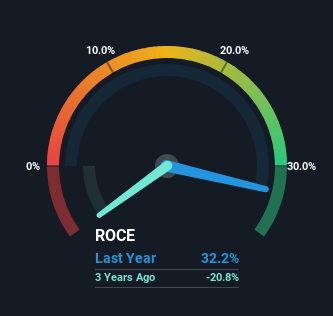We Like Tethys Petroleum's (CVE:TPL) Returns And Here's How They're Trending
There are a few key trends to look for if we want to identify the next multi-bagger. One common approach is to try and find a company with returns on capital employed (ROCE) that are increasing, in conjunction with a growing amount of capital employed. This shows us that it's a compounding machine, able to continually reinvest its earnings back into the business and generate higher returns. And in light of that, the trends we're seeing at Tethys Petroleum's (CVE:TPL) look very promising so lets take a look.
What Is Return On Capital Employed (ROCE)?
For those that aren't sure what ROCE is, it measures the amount of pre-tax profits a company can generate from the capital employed in its business. The formula for this calculation on Tethys Petroleum is:
Return on Capital Employed = Earnings Before Interest and Tax (EBIT) ÷ (Total Assets - Current Liabilities)
0.32 = US$29m ÷ (US$104m - US$13m) (Based on the trailing twelve months to September 2023).
So, Tethys Petroleum has an ROCE of 32%. That's a fantastic return and not only that, it outpaces the average of 10.0% earned by companies in a similar industry.
View our latest analysis for Tethys Petroleum
While the past is not representative of the future, it can be helpful to know how a company has performed historically, which is why we have this chart above. If you want to delve into the historical earnings, revenue and cash flow of Tethys Petroleum, check out these free graphs here.
What Can We Tell From Tethys Petroleum's ROCE Trend?
Tethys Petroleum has recently broken into profitability so their prior investments seem to be paying off. The company was generating losses five years ago, but now it's earning 32% which is a sight for sore eyes. Not only that, but the company is utilizing 56% more capital than before, but that's to be expected from a company trying to break into profitability. This can indicate that there's plenty of opportunities to invest capital internally and at ever higher rates, both common traits of a multi-bagger.
On a related note, the company's ratio of current liabilities to total assets has decreased to 12%, which basically reduces it's funding from the likes of short-term creditors or suppliers. Therefore we can rest assured that the growth in ROCE is a result of the business' fundamental improvements, rather than a cooking class featuring this company's books.
In Conclusion...
Overall, Tethys Petroleum gets a big tick from us thanks in most part to the fact that it is now profitable and is reinvesting in its business. Since the stock has returned a staggering 104% to shareholders over the last five years, it looks like investors are recognizing these changes. In light of that, we think it's worth looking further into this stock because if Tethys Petroleum can keep these trends up, it could have a bright future ahead.
If you'd like to know more about Tethys Petroleum, we've spotted 4 warning signs, and 1 of them makes us a bit uncomfortable.
If you'd like to see other companies earning high returns, check out our free list of companies earning high returns with solid balance sheets here.
Have feedback on this article? Concerned about the content? Get in touch with us directly. Alternatively, email editorial-team (at) simplywallst.com.
This article by Simply Wall St is general in nature. We provide commentary based on historical data and analyst forecasts only using an unbiased methodology and our articles are not intended to be financial advice. It does not constitute a recommendation to buy or sell any stock, and does not take account of your objectives, or your financial situation. We aim to bring you long-term focused analysis driven by fundamental data. Note that our analysis may not factor in the latest price-sensitive company announcements or qualitative material. Simply Wall St has no position in any stocks mentioned.

